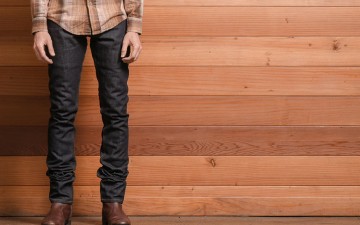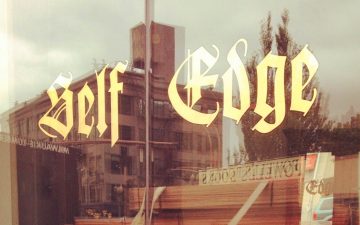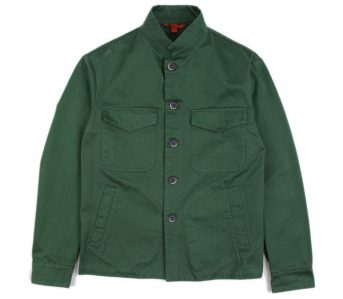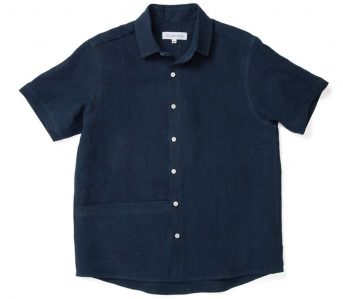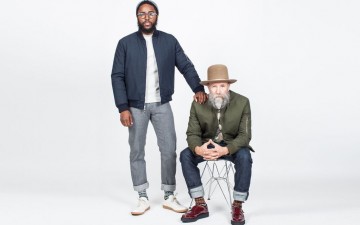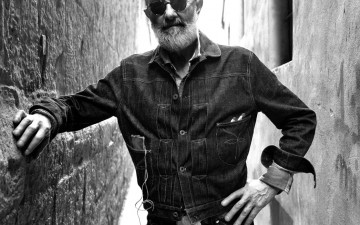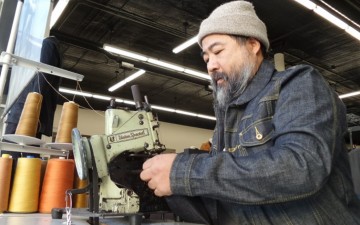
There’s no shortage of heritage and workwear brands. Close your eyes and click around our site and your blind hyperlinking will yield just that. But Krammer & Stoudt’s roots aren’t set so much in coal mines as in the sands of sunny California. The brand has made a splash for itself, claiming SoCal as their source of inspiration, but it’s not all board shorts and graphic tees.
We had the chance to chat with Mike Rubin and Courtenay Nearburg, partners and creators of Krammer & Stoudt, about how they went from creating sets for Disney and fashion photography (respectively), to creating the East Coast label with West Coast cool.
Heddels (Gerald Ortiz): What were you up to prior to K&S? What was the impetus for wanting to start the brand?
Courtenay Nearburg: Prior to starting K&S, I was shooting portrait, lifestyle and editorial photography, and just getting interested in fashion photography. Mike had been the supervisor of a scenic art department at Disney for 12 years after graduating CalArts, and decided to leave the corporate art world just around the time we met. For some time, he focused on creating electronic music, after leaving Disney, but decided that pursuing that as a career just wasn’t for him, in his forties (haha).
So I convinced him that he should style some of my experimental fashion shoots, and he liked doing that. He started making some noises about learning to sew and creating his own clothing. It was like a light bulb went off in my head. I basically pushed him to start sketching a collection, and we took the sketches to some of my photo clients who happened to also have an apparel manufacturing business. They in turn took us to our first fabric sourcing show at the CalMart in downtown LA. Within a year, we had our first two collections. They were weird, I would say, as we were just figuring out what the hell we were doing, and how you develop a brand, simultaneously. But it was critical experience for us, and we learned a ton that first year.
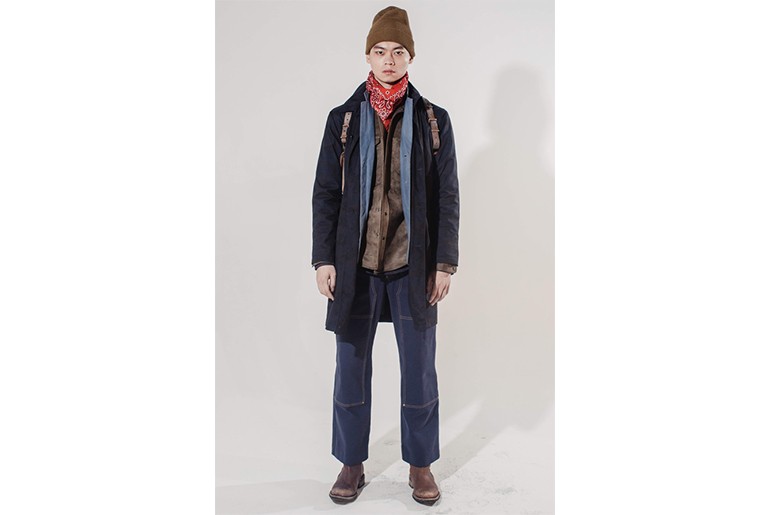
H: I noticed that you had a Kickstarter to raise funds for your second season, which was back in 2013. How did you get the first collection started? Was K&S a full-time commitment, or were you working elsewhere while getting K&S off the ground?
CN: We started in 2012 out of our house in Anaheim with cash we got from family and friends for our ‘honeymoon’. We used the cash to pay for our first samples, which were made in Orange County by the clients I had with the factory. We financed ourselves later that year with the Kickstarter campaign, which pretty much forced us into our first production run. Mike was still sewing some of the ‘perks’ of the Kickstarter campaign when we moved to New York in August of 2012. I had applied to the School of Visual Arts for a graduate fashion photography program, and we agreed that if I was accepted, we would make the move to NYC and give K&S a go in the big city, where we felt the real competition operates. I knew I would meet some great industry people by going to SVA, plus have a creative community upon arrival. What we didn’t know was that NYC would provide so many relationships in the menswear industry so quickly, and with people who would really guide us and inspire us to be the best we could be.
K&S wasn’t full time for me, as a working photographer in SoCal, and Mike had a business doing faux painting to make ends meet while we were starting the brand. We left that in Cali, and I did school full time when I moved to the city. Mike used that year I was in school to familiarize himself with the garment district and find fabric agents we could work with. Within 6 months of my graduation from SVA in May of 2013, it was clear that K&S would have to be full time for both of us. There was no way we could keep up the pace without dedicating ourselves.
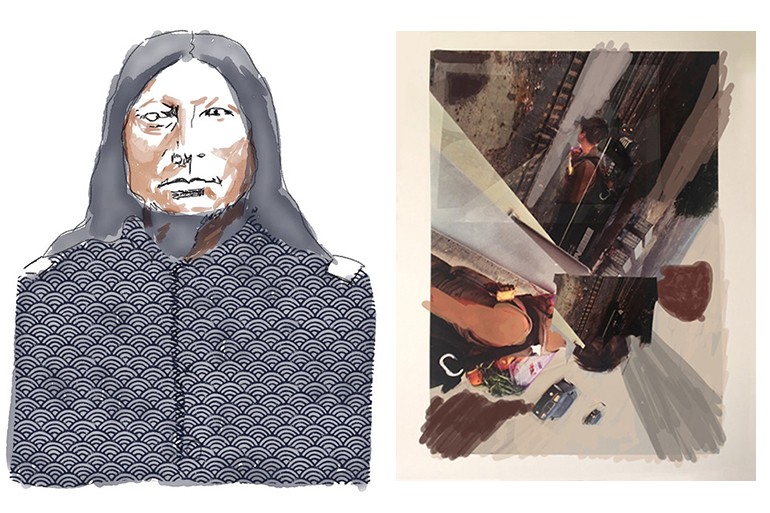
Paintings by Mike Rubin
H: Where does the name Krammer & Stoudt come from?
Mike Rubin: Krammer is my mother’s maiden name and Stoudt is my real father’s name. They’re family names with German and Dutch roots.
H: Though you have an extensive creative background, none of it was ever in fashion. How did you first get the fashion bug?
CN: Mike had always been into vintage as well as thrifting and modifying clothing, mostly from the early 80s SoCal punk scene he was hanging out in. As I got deeper into photography, I developed an appreciation of fashion photography as an art form, and began to explore working in that medium. Mike is really the most creatively stylish guy I had ever met, and it seemed really natural to me that he should translate his myriad of creative skills, developed from studying painting, sculpture, and video performance both at San Francisco Art Institute and CalArts, and his history working in a commercial art form, to fashion. Sometimes you have no idea that, over many years, you are amassing skills that will contribute to a larger purpose later. That’s basically what happened with us.
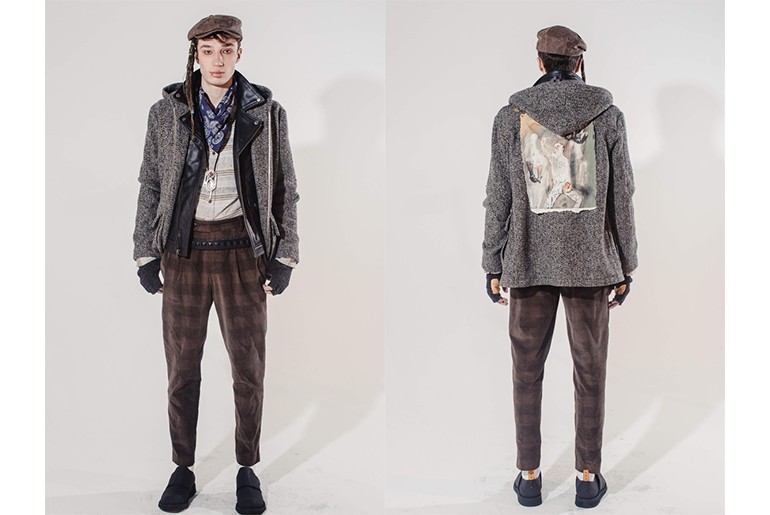
H: What was it like working as a set designer for Disney?
MR: I was doing similar work for the theatre in Berkeley and San Francisco area before Disney. Disney had much larger budgets so I learned a lot more there. We mostly worked on promotional campaigns for new movies and special events.
H: Does the work you did there manifest itself in K&S?
MR: Mostly in the work ethic I had to develop there. Once we started doing the New York Men’s Day show, we began to conceive shows creatively. It is like working in theater again — working with the space, and creating a set design with my collaborator and friend, Gavin Baker, of 10k Studios.
I would say also that my color sense was highly developed at Disney over years of working in paint. I think that applies to my sense of palette for each collection; and we’ve received compliments as inexperienced designers on how cohesive the palettes tend to be. I have to give Disney credit for that.
H: How did growing up in Southern California shape the brand identity?
MR: I was always interested in making art since high school. I was surrounded by a lot of outsiders in the surfing community. Surfing wasn’t such a trendy endeavor then as much as it was a lifestyle to escape from the norm. But as soon as surfing started becoming commercial and more widespread, some of us gravitated to the new punk scene and started playing instruments. We always wanted to dress and look different to shock people in Orange County. So we went to a lot of thrift stores to find odd things to wear. We didn’t care about making money because you didn’t need a lot to move out on your own. There was more room to lead what I look back on as an “experimental lifestyle”. I think that part of my life is probably the part I draw the most from in terms of ‘attitude’ in K&S. I want people who wear our brand to feel something, just that outsider feeling, even if it’s only one piece that makes a statement; to draw attention, whether it’s positive or negative, really. Kind of a ‘fuck you’ to the norm.
I think I should add my Austrian grandfather had a lot of influence on me, too. He was a severe DIY kind of guy. He taught me a lot: how to work on cars, how to do anything yourself so you don’t have to rely on someone or something else to make do. I think I apply that in K&S; in just figuring out how to do it and do it well.
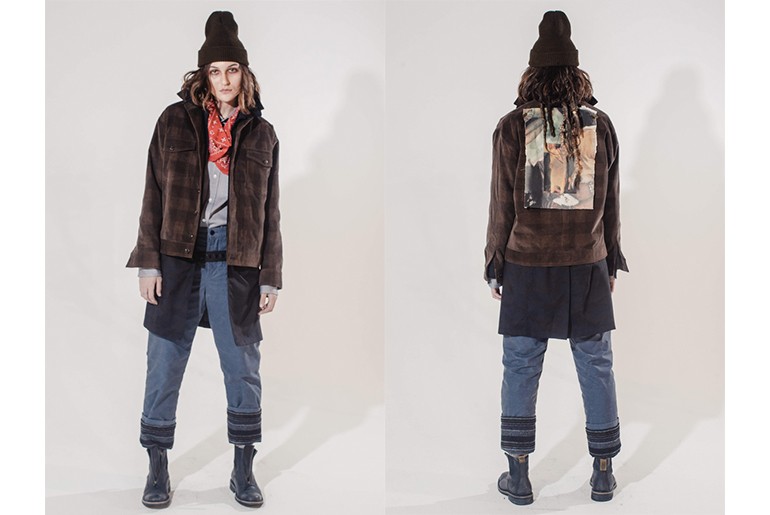
H: Even though the brand’s aesthetic has its roots in Southern California, you produce a lot, if not all of your garments, in New York. What’s the reasoning in choosing to produce there as opposed to Los Angeles?
CN: We found instantly that producing in New York is so much easier than it had been in California, at least when we started in 2012. Mainly, that has to do with the compactness of the Garment District and the difficulty of getting multiple things done while battling traffic in LA. Being able to take the train to the Garment District and walk to do the errands and visit the factories is a godsend. Mike can do lots of things in one day here that might take 3 days to accomplish in LA. It’s crazy. However, we’ve seen a dramatic improvement in the development of the fashion manufacturing industry in LA since we’ve been doing this, and we’re now going to move some production back to LA because it is actually far more economically viable.
I think the folks in the Garment District labor under the same challenges that people living here do. It’s crazy expensive rent and that translates into high labor costs for manufacturing here in the city. The quality has been great here, but we know some awesome brands out west doing high quality goods there exclusively, at a much better price for the margins. So it’s time to take some things back.
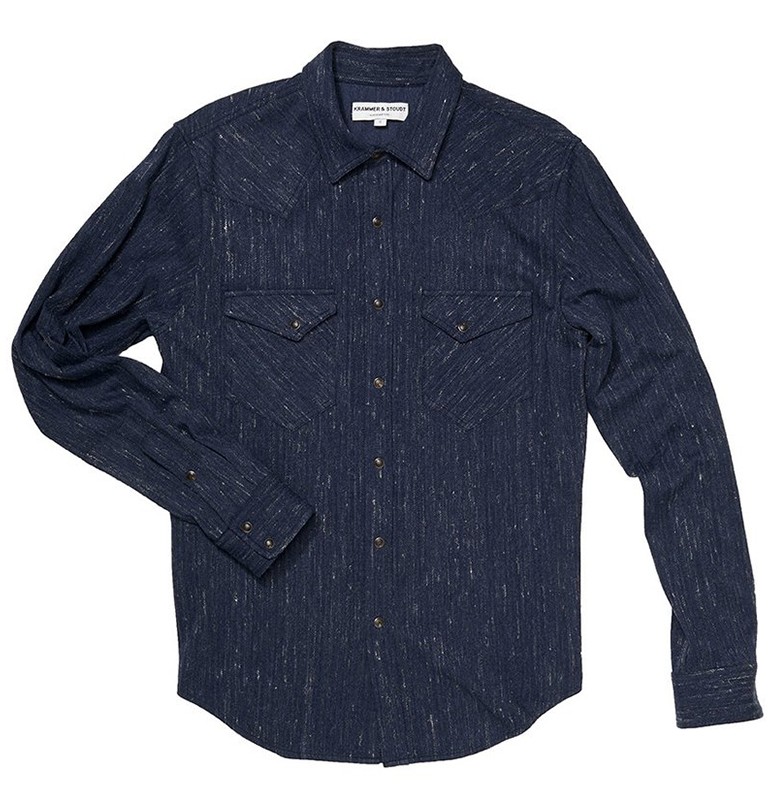
Navy Wayne Western Shirt
H: Where do the fabrics come from? How do you go about choosing fabrics? I’m sure your background as an artist comes into play, no?
MR: We’re forced to get a majority of our fabrics from overseas, simply because there is no textile industry here to speak of. I’m drawn to texture and color in fabrics the same way I am drawn to texture and color when I look at the surfaces of paintings. I’m all about texture and color.
H: The collection seems to pull from all sorts of inspiration, from surf to classic tailoring, to punk and Southwestern influences. Where does the inspiration come from?
MR: I like Picasso’s quote: “Inspiration finds me working”. designers use a lot of the same sources, it’s just a matter of how each of us puts it together for the final show.
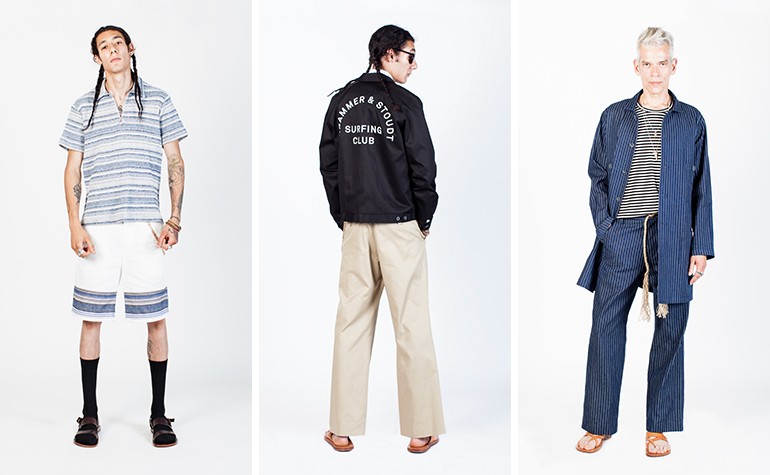
Krammer & Stoudt Spring/Summer 2017
H: How does working as a photographer translate/shape the work you do at K&S?
CN: I feel like I act as a curator for Mike. He has a super active imagination and his creativity has no bounds. He constantly surprises me with the ideas he has. I feel like all the visual research I have done as a photographer helps me cull the ideas and edit the collections into cohesive bodies. I have a pretty organized mind compared to his limitless one. I pick through all the ideas flowing and point to the life experiences and influences he has that I know about, kind of like a psychologist, and help him focus the ideas into one message per season. I think that’s actually a pretty good description of how a photographer works with a subject, be it human or inanimate. The world is like Mike, full of ideas and creativity. The photographer selects and frames aspects of that infiniteness for an image.
Practically speaking, working as a photographer, you often have to shape your creativity to the work at hand. For example, you may be working for a brand, and you need to show the garments clearly, or convey the message of the brand or the collection, using your creativity, but also practicality. The work often needs to be fit into a time frame for the production of the actual shoot, and for a hard deadline for delivery. These are issues constantly at play in fashion as well. I’m pretty much the disciplinarian on budget, commerciality, time management. Haha.
H: Courtenay, how does your background as a fashion photographer go beyond the camera and into the designs themselves? Do your Texas roots influence the brand at all?
CN: For sure, I had more experience looking at fashion as art, and thinking about current designers and where the fashion world is going. But Mike has become very serious about his research into the current environment, as well as the history of fashion, so we are pretty much even on that these days. I am afforded the privilege of contributing to the design process by helping Mike edit and pushing him to explore different silhouettes that he might not think of since they wouldn’t necessarily be something he would wear himself. I feel very creatively satisfied by that participation, for sure.
My roots play into this mainly because I took the surfer guy to Austin to see my family, and introduced to him to the best of Texas culture, food and music. I also introduced him to New Mexico, where we have our little off the grid cabin now. Now he struts around NYC in cowboy boots, vintage Stetsons and native Southwestern jewelry. What can I say? I created a monster.
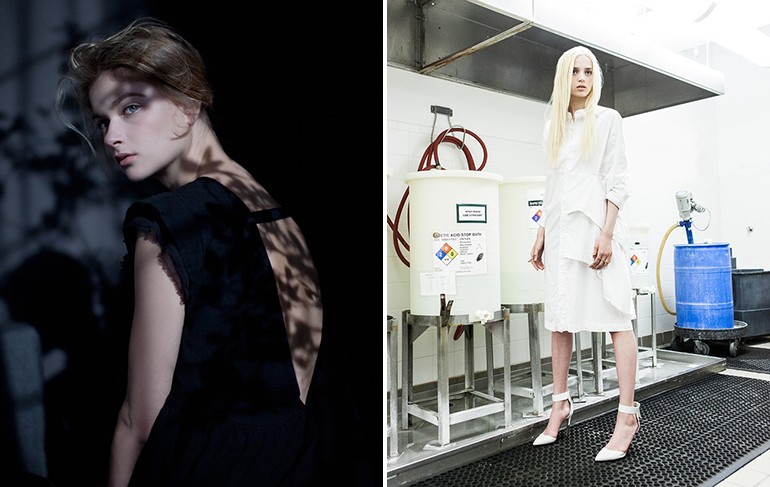
Fashion photography by Courtenay Nearburg
H: I imagine that an off the grid cabin can be a place to get away from everything and just rest as well as a place to get some real creative work done. Do you use the cabin to work on Krammer & Stoudt? Or is it strictly for relaxing and tuning things out?
MR: Getting away from the hum of the city grid produces a different state of mind. I go there to work on the cabin and hang out at a coffee shop with some locals in the summer. We talk for hours. We go swimming in the Rio Grande when it’s hot. In the winter we go snowboarding and to the hot springs. It’s really quiet in the winter and more lively in the summer there.
I experience a different kind of creativity there than I do in New York. I think it’s a more reflective kind of creative thought process whereas New York requires me to be in a more, “get it done” state of mind, with less creative reflection time. The intention of going there is to relax, but I’m the kind of person who always needs to be doing something. It’s where I think about what’s next.
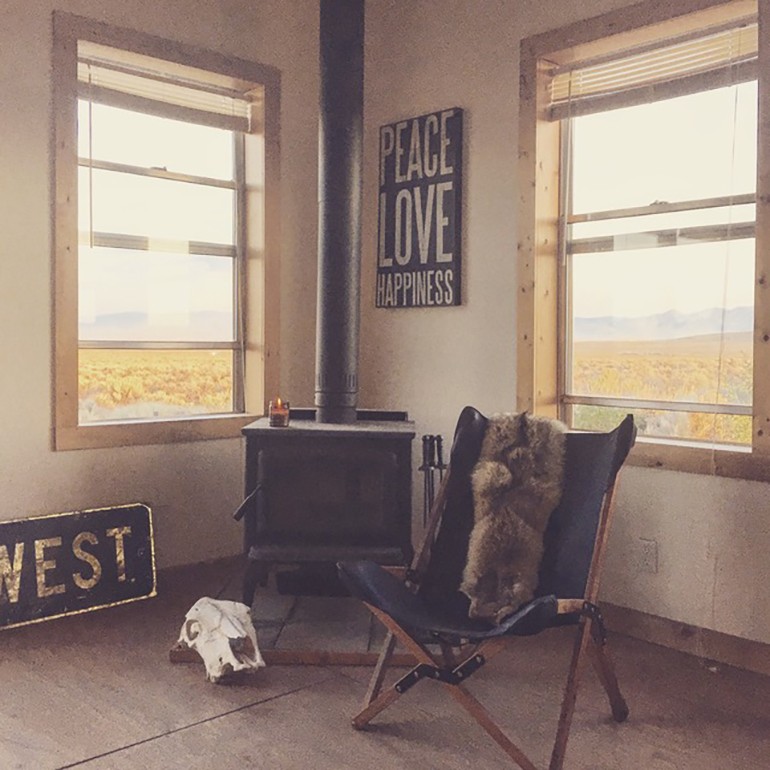
H: How does your relationship as designer and photographer work to create a garment/collection?
CN: We are pretty streamlined when it comes right down to it, but getting there can be pretty dramatic. I’d say our relationship as a married designer and photographer is probably the most challenging aspect of doing this. We live, eat, breathe, and work together full time. That can be taxing. It’s not like either of us is a pushover, either. Both of us have German roots and we are stubborn as hell. Our employees get a good fireworks show here and again, haha. But in the end, we are always really proud and really happy. And we recognize that our partnership in life and work is pretty damned awesome. I’m pretty much constantly amazed at how well things have gone for us in this adventure.
H: What life story can we see infused into the next collection?
MR: Romanticizing my youthful days (60’s/70’s SoCal) of being in the sun and ocean everyday without a care in the world. Camping trips with my grandparents to Baja when it was still just untouched wilderness and beach.
H: Courtenay, who’s your favorite photographer?
CN: Favorite photographer is Viviane Sassen, a Dutch fashion/art photographer from Amsterdam.
H: Mike, who’s your favorite punk band?
MR: Wire. It was the most influential band for me. Their first album Pink Flag had like 50 songs on it. All the songs were only one to three minutes long. I thought to myself, “I could do that”.
H: Anything you’ve got got going on in the near future?
Next week, in Los Angeles our wonderful retailer Ron Robinson will be hosting a great event pre-Coachella called ‘Festival Days’ on the 13th, where folks in the LA area can pick up their essentials for the weekends before heading out to the desert.
In Los Angeles, on April 13th as well, our wonderful retailer Ron Robinson (located inside Fred Segal on Melrose) will be hosting a pre-Coachella party called ‘United State of Fashion’, highlighting Made in the US brands carried by Ron Robinson. Folks in the LA area can pick up their essentials for the weekends before heading out to the desert.
We just joined new retail boutique in New York City that opened Thursday, April 6 called Finer Fields, 199 Lafayette St. We’re very excited about their fresh approach to the retail market, focused on a quality experience with the brand.
We have hosted several screenings this spring, of a new surf documentary called ‘Surfer’s Blood’, by Patrick Trefz, a celebrated filmmaker and photographer. We’re really excited to join Patrick at Wheels and Waves in June, in Biarritz, France. Seriously. He will screen the film and have a photography show, and we will present the screening and host a preview of the SS18 collection at his photo show there.
And we are thrilled to be celebrating our very first in-store Pop Up with The Brooklyn Circus at their Brooklyn location on Nevins Street. The opening party will be Friday, April 21 from 6-9pm, with live music.
We will also debut two short films Patrick is working on for us, at Wheels and Waves. The shorts will be filmed in Paris, with one focused on the skate scene in Montmartre, featuring our upcoming sneaker collab with a Dutch brand called Mason Garments. The other short will document a Parisian surfboard shaper creating a custom board for K&S, which Mike will airbrush on site at Wheels and Waves, and we will make available on special order. We’re pretty excited about these projects!
H: Thanks so much for taking the time.
Learn more about Krammer & Stoudt at their website.

